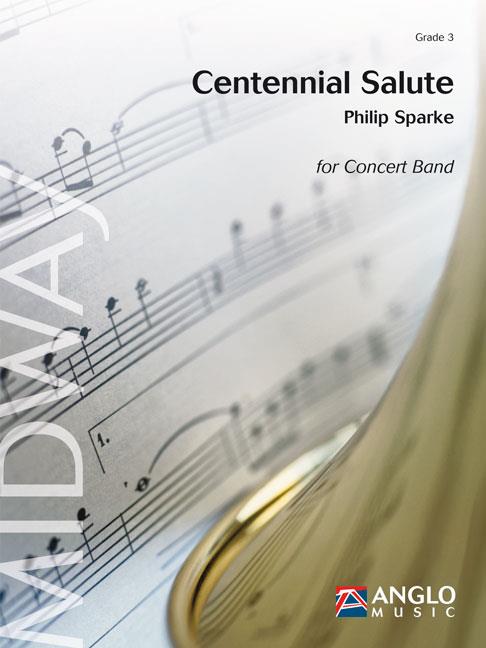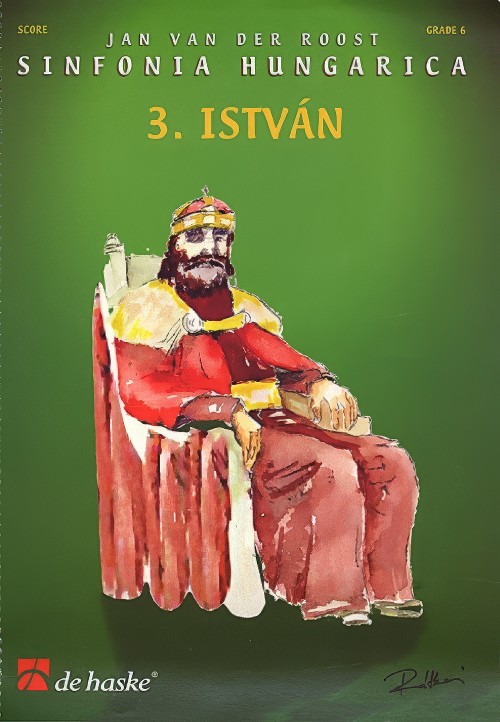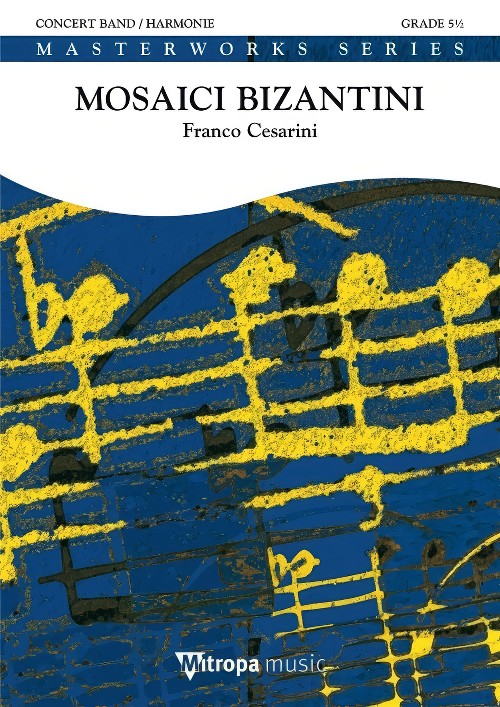Results
-
 £152.99
£152.99Centennial Salute (Concert Band - Score and Parts) - Sparke, Philip
Just based on its title, this piece has to be celebratory and up-beat, which it is! It opens with a stately fanfare, first played on the low brass before the entire band joins in. This gives way to a contrasting lyrical theme which develops until it joins up with the fanfare to complete the opening section. A lively and heavily syncopated vivo follows, cast as a traditional march, complete with a 'bass strain' and trio. After the original march theme returns, a climax leads back to a reprise of the majestic opening, which brings the piece to an appropriately triumphant close.Duration: 7:30
Estimated dispatch 7-14 working days
-
 £69.99
£69.99Infinity and Beyond... (Concert Band - Score and Parts) - Sparke, Philip
The last decades of the 20th century saw man's first steps in space exploration. Since the first moon landing by Neil Armstrong in 1969, these adventures in outer space have captured the public's imagination and have given birth to scores of science fiction movies, books and TV series that have tackled the subject. Infinity and Beyond... takes as its inspiration the wonderful film scores of composers such as John Williams and Jerry Goldsmith, who have almost invented a style which could be called 'space music'.Opening with a rhythmic bass figure, Infinity and Beyond... begins with a robust introduction in 3/4, which leads to the main theme in 4/4, played by the full band. A short bridge passage, utilising the interval of a fourth, leads to a modal central section, featuring first the trumpets and then played by the whole band; this in turn leads back to a repeat of the introduction until the main theme returns to bring the piece to a close.Duration: 3:00
Estimated dispatch 7-14 working days
-
 £239.99
£239.99Istvan (Part 3 from Sinfonia Hungarica) (Concert Band - Score and Parts) - Van der Roost, Jan
Sinfonia Hungarica is a three-movement symphony that depicts the history of Hungary. All three movements were inspired by historical key figures, wars, and other important events from this country. This symphony is a celebration of Hungary's millennium in 2001.The final movement is named after Istvan, the King who introduced Christianity into Hungary and who was crowned by Pope Silvestro II on January 1, 1001. A rather solemn start leads to another war-like passage, ending with some loud crashes. This symbolizes the fact that the body of the pagan Koppany was cut into four pieces, and sent to the four castles of the country as an example. After a quiet, almost religious intermezzo, the National Hymn of Hungary is introduced. This broad "grandioso" ending also has a symbolic meaning: after ten centuries, Hungary has many reasons to look back on the past with pride, and to look forward to the future with optimism and confidence.Duration: 14:30
Estimated dispatch 7-14 working days
-
 £233.50
£233.50Mosaici Bizantini (Concert Band - Score and Parts) - Cesarini, Franco
Three Byzantine mosaics, to be seen in churches in Venice and Palermo inspired Franco Cesarini to compose this work. He took the musical motives from Gregorian chants. The mosaics concerned depict the following extracts from "The Gospel According to St. Matthew".I. The Nativity: The Magi from the East: "Where is the new-born King of the Jews? For we have seen his star in far-off eastern lands and we have come to worship Him."II. The Temple of Jerusalem: And look! The curtain secluding the Holiest Place in the Temple was split apart from top to bottom: and the earth shook and rocks broke, and tombs opened and many godly men and women who had died, come back to life again.III. Angel of the Resurrection: An angel of the Lord come down from heaven drew near, rolled away the stone and sat upon it. His countenance was lightning and his attire white as snow.Duration: 19:45
Estimated dispatch 7-14 working days
-
 £84.99
£84.99Variations on a Theme by Elgar - Árpád Balázs
In rpd Balzs's diverse and varied oeuvre, works for wind orchestra play a prominent role alongside choral music. He composed the Elgar Variations in 2022 on the theme of one of Edward Elgar's (1857-1934) short early works (Love's Greetings, 1888). As rpd Balzs writes ''The theme I used as the starting point for my work may already be considered a variation, since I 'peeled off' the dense ornamentation and the tonicisations from it, and what remained was the melody, beautiful in its own place. What come back from time to time from the theme in the variations are: the arched structure, the double peak point, and mostly the major sixth leaping downwards, then upwards. The modest, transparent orchestration, which then is amplified at the repetition of the theme is also a defining feature. There is a personal family secret hidden in the third variation: a late compliment to a loyal spouse for the past half century... The closing variation is calm and quiet - similarly to the chorale-like slow movement in Bla Bartk's 3rd Piano Concerto. It is like a message from an old composer to the Future.'' The Elgar Variations together with the Concertino (1992, Z. 14909) and the Rhapsody (2015-2021, Z. 15167) form an ambitious, emotionally wide-range trilogy for a concert band.
Estimated dispatch 7-14 working days
-
 £149.40
£149.40Lamento - Jerker Johansson
Lamento was composed in memory of Bjarne Haug Thesen (1957-2023). Bjarne came from Nord-Odal and had his musical base in Mo Skolemusikk and Nord-Odal Hornmusikk. In 1987, he was elected vice-president of the Norwegian Band Ferderation (Norges Musikkorps Forbund - NMF), a position he held until 1990. He was an important contributor to the development of the organization and is remembered for his knowledge, bold thoughts and winning spirit. Bjarne had this gift of delivering stories that fit to the issues that were up for debate, and if things started to get a little heated, these inputs from Bjarne often ensured that the debate got back on track. He was on the editorial board for the book "Norske musikkorps" which was published in 1990, and was also involved in the 100th anniversary of the NMF in 2018. Lamento was premiered on the 13th of December 2023 by Oslo Postorkester conducted by Stina Widn.
Estimated dispatch 7-14 working days
-
 £62.95
£62.95Once Upon a Time Signature - Vince Gassi
Themes are pliable; they can evolve and exist in more than one time signature. Once Upon a Time Signature is the perfect opportunity for your young musicians to improve their craft by adapting to frequent changes in time. 4/4 to 3/4, and back again, they will rise to the challenge. Count on it!
Estimated dispatch 7-14 working days
-
 £96.00
£96.00Salutation - Eriks Esenvalds
Salutation was originally composed for a cappella choir to a poem by Bengali poet and musician Rabindranath Tagore (1861 1941). The music takes up the spiritual message of the poem, that we live our lives in one salutation to God ending back in an eternal home. Phillip Littlemore's brilliant arrangement for concert band adds a work of great contemplative beauty to the repertoire. Band Grade 2.5
Estimated dispatch 7-14 working days
-
 £159.99
£159.99A Little Stress Music - Thomas Doss
A Little Stress Music was commissioned by the Lenzing Werkskapelle from Austria and comprises of four sections. 'Rush Hour' depicts a Friday evening during which everyone wants to get home after work. Unfortunately, traffic jams and gridlock stand in the way! In 'Promenade Waltz' you can picture an evening walk along the beautiful lakeside, then a glass of wine loosens you up leading to the third movement: 'Romance', which starts with a promising conversation...The funny finale 'Monday Morning' brings you back to reality and the score provides the option of the band applauding itself for a job well done! A humorous and joyful new piece by Thomas Doss!
Estimated dispatch 7-14 working days
-
 £137.99
£137.99Eldorado - Thierry Deleruyelle
The myth of El Dorado ("the golden one") stems from the story of a powerful chief who used to cover himself with gold dust before bathing in a sacred lake where he threw precious objects as offerings to the gods. The myth was soon relayed to the Spanish conquistadors and inspired many expeditions, although the invaders didn't bring back nearly as much gold as they expected, if any at all. Eldorado is a mysterious and dynamic work that illustrates the myth of the golden man and the European expeditions that followed. With a touch of exotic influences, the music is varied and rich. This piece was commissioned by the French Cultural Association Lille 3000 as part of theirEldorado-themed festival in 2019.
Estimated dispatch 7-14 working days
